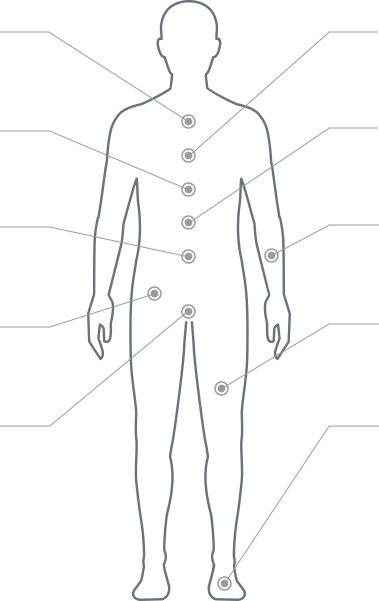Top Four Myths and Facts About Chronic Pain Management

There are many myths and misconceptions about chronic pain management. And even though many people experience chronic pain, it’s often misunderstood. Understanding the facts about chronic pain is a key step to better pain management.
If you’re living with chronic pain, you know how it impacts every aspect of your life, from relationships to hobbies to careers. You are not alone.
Many people with chronic pain are forced to miss out on family activities, not lead the life they want to live and feel like they’ve lost their independence.
Let’s debunk the myths and learn the facts. Here are four common myths about chronic pain management and the truth behind them:
Chronic Pain Management Myth #1: My injury healed, so my pain should be gone
It’s important to know there are two different types of pain. Acute pain usually comes on suddenly and goes away with time. It’s often a result of a broken bone, burn, cut, or surgery or illness – like appendicitis. Acute pain will resolve itself eventually.
However, chronic pain is a different story. Chronic pain is persistent and debilitating. It’s experienced even after an injury heals and everything looks “normal”. If you’ve been experiencing pain for more than three months, it’s considered chronic.
So why does chronic pain stay, even when your injury healed? Sometimes injuries can cause permanent damage to nerves. Nerves that are damaged overproduce and send “false” pain signals to your brain. So, while everything appears to be okay on the outside – the damaged nerves are telling your body you’re in pain; causing you to feel pain.
It’s more common than you think to experience pain years after an injury like a fall or car accident, and many people with chronic have been experiencing pain for decades.
Learn more about the different pain types and the treatment options available.
Chronic Pain Management Myth #2: Some people don’t believe that I’m really experiencing chronic pain; maybe it’s not as bad as I think it is
This is simply not true. The chronic pain management facts are, that everyone experiences pain differently, and pain is difficult to measure. This is one of the reasons it’s often misunderstood. Sometimes people think that there has to be an injury or a precise diagnosis to experience pain. And unfortunately, doctors aren’t always able to pinpoint the cause of pain.
Just because you don’t know why you are experiencing pain doesn’t mean it isn’t real. It is. You’re not imagining your pain. The pain is not in your head.
At times, it may feel like no one understands your pain. People who have never experienced chronic pain tend to think it’s easy to live with. They don’t get how much chronic pain can impact your day-to-day life.
If you’ve been dealing with your pain for a long time, you know the ‘grin and bear it’ and ‘I’m okay’ facade all too well. It’s important for your family and friends to understand that just because you got out of bed and put on a smile, it doesn’t mean you’re not in pain.
It can be hard for your family and friends to understand exactly what you’re going through. Having support while navigating your chronic pain management journey can make a huge difference.
Click here for information your family and friends may find helpful to better understand what you’re going through.
Chronic Pain Management Myth #3: Opioids are the most effective option for chronic pain relief
There is a common misconception that to experience relief from chronic pain, it must be treated with opioids. While they can be useful, opioids don’t treat the source of pain. Instead, they mask pain. If you’re considering opioids or other prescription medications, be aware of side effects, like constipation. There are also significant risks for addiction that you need to discuss with your health care provider before starting medicines like opioids.
Thankfully, there are many other effective treatment options for people who are experiencing chronic pain. Other treatments, including spinal cord stimulator systems, are designed to provide long-lasting relief – especially for those who have not found relief with more traditional treatments. They also have fewer side effects than prescription medications like opioids.
Chronic Pain Management Myth #4: Everyone experiences pain as they get older; it’s just part of aging
Often people think that chronic pain comes with age. They buy into the myth that pain is inevitable and part of the natural aging process. As we get older, we can expect to have a few more aches and pain. But chronic pain is different and is not part of your body’s normal wear and tear.
Your chronic pain shouldn’t be thought of as an inevitable part of aging. You should treat chronic pain like the medical condition it is and talk to your doctor about your treatment options.
Talking to your doctor about your chronic pain
We know understanding pain can be difficult. How can you describe to another person what you’re experiencing? You have a right to express yourself. Talking honestly about what you’re going through can help your doctor find the right treatment option for you.
Here are some tips for describing pain to your doctor:
• Be specific. Tell your doctor exactly where you’re experiencing pain. If you’re experiencing back pain, say if it’s lower, mid, or upper back pain and which side of your back (left or right).
• Be descriptive. Use specific words like sharp, stabbing, burning, aching, or radiating. Let your doctor know if your pain moves around.
• Make comparisons. If you can, compare your current pain to other types of pain you’ve experienced in the past, like appendicitis or kidney stones.
• Give details about your day. Is your pain more intense in the morning or at night? Does it get worse if you’re stressed out? It’s important to know how your pain changes throughout the day. You can say something like, “When I go to bed, I feel a sharp pain in my lower back. It lasts about two hours.”
• Talk about function. Do certain activities trigger your pain or make it worse? What does your pain prevent you from doing? How does it interfere with your day-to-day life?
• Share your treatment history. Talk to your doctor about the history of your pain – what caused your pain? How long have you been experiencing it? How has it changed over time? What treatment options have you tried?
Find more information about when and how to talk to your doctor about chronic pain here.
Talk to a pain management provider about your chronic pain today
So now that you know the facts about chronic pain management, never tough out your pain. The sooner you see a doctor, the sooner you’ll be on your way to finding pain relief. Pain that was once considered hopeless is now manageable.
To get the best chronic pain management and care, it’s important to work with doctors who are trained and experienced in treating chronic pain.
Pain management doctors have received extensive specialized training to tackle pain issues specifically and are the most qualified source of expertise to evaluate, diagnose, and treat chronic pain. They’re here to help you explore your treatment options and help you restore your quality of life.
It’s important to address your pain before it gets worse. Usually, seeing a pain management doctor doesn’t require a referral. Needing a referral depends on the policies of pain management providers in your area and your insurance.
If you and your primary care provider have tried all possible treatment options without success, the next best step you can take is to use the physician finder tool to find a pain management doctor in your area or ask your primary care provider for a pain management referral.
The sooner you see a pain management doctor, the sooner you’ll be on a path to finding pain relief and getting your life back.
Summary
- Many myths and misconceptions exist about chronic pain
- Understanding the facts about chronic pain management is a key step
- Finding a pain management specialist is the first step toward relief
Popular Posts
Take our short assessment to find out if HFX is right for you.
Start NowHFX is covered by all major commercial insurance plans, Medicare, Medicaid, and Tricare.
DOWNLOAD INFORMATION BROCHURERelevant Reads
What to Expect at Your Nevro HFX Consultation
You’ve decided to explore Nevro HFX as a treatment option for your chronic pain. Congratulations! That’s the first step in finding a long-term pain relief solution that doesn’t require drugs or major invasive surgery. A…
How to Choose the Right Pain Management Doctor
If you’ve been living with chronic pain for a long time, you’ve probably tried a wide range of treatment options recommended by your primary care provider. Maybe you’ve tried over-the-counter and prescription medications, physical therapy,…
Why Do I Need a Psychological Evaluation for a Spinal Cord Stimulator?
A spinal cord stimulator is a highly effective treatment option for managing chronic pain. It’s a solution for many people who have tried other ways to manage their pain but haven’t found success with medications,…
How long have you been suffering from pain?
Where is your pain located?
(Select all areas where you experience pain)

On average, rate your pain level over the past 30 days:
No Pain
0 1 2 3 4 5 6 7 8 9 10Worst Pain Imaginable
No Pain
Worst Pain Imaginable
Which treatments have you already tried?
(Select all options you've tried)
What statement describes you best?
Please select your primary type of health insurance:
HFX is covered by all major insurance plans, including Medicare and Tricare.
Commercial insurance is typically offered through your employer or health care exchange. Examples of commercial insurance providers include Blue Cross Blue Shield, Aetna, Cigna, Kaiser, United, and Humana. Close
Thank you for sharing your experience.
At this time, it looks like you might not be an appropriate candidate for HFX. The next best step is to talk with the physician who is treating your pain about your treatment options.
To learn more about who this treatment option is right for, visit our learn center:
Learn MoreOne of the qualifications for HFX is that you need to experience pain for longer than 6 months.
You may not be ready for HFX now, however if your pain lasts longer than 6 months, please come back to see if you qualify.
Learn MoreOne of the qualifications for HFX is that you need to experience moderate to severe pain.
You may not be ready for HFX now, however if your pain severity increases, please come back to see if you qualify.
Learn MoreGood news!
Based on your responses, HFX could be an option for you.
Fill in your information below to get your doctor discussion guide and additional educational information about HFX.
Fill in your information below to connect with your HFX Coach and receive your doctor discussion guide. Your HFX Coach is a real person assigned to you who will answer your questions and help you find an HFX doctor.
Agree to terms
By clicking ‘I agree & submit’, you agree to receive automated SMS texts from Nevro at the mobile number provided and agree to Nevro’s Text Message Terms of Service & Privacy Notice. Message and data rates may apply. Message frequency varies. You can opt-out at any time by texting STOP to 35788. You can also text HELP to 35788 for HELP. You also agree to email and phone communications from Nevro and opportunities to participate in Nevro led research panels and quantitative surveys. You understand that you can choose to participate or decline to participate in any marketing panel. You understand that you can opt-out of further advertising and/or marketing research communications from Nevro by clicking unsubscribe in the email or providing a detailed request to [email protected].
All information will be used in accordance with Nevro’s Privacy Notice.
Looks like you have recently taken the assessment.
Would you like to update your responses?
Your responses are being submitted. Please wait – we’re sending you to a page with more information about HFX.
Please don't click the back button or close your browser. This may take a few seconds.
Your responses have been saved.
Thank you for your time.
Your results and discussion guide will be on their way shortly.
Please find a copy at the email address provided.
Thank you for your time.
We did not update your responses. Your results and discussion guide will be based on your previous responses. Please find a copy at the email address provided.
YOU ARE ABOUT TO EXIT FOR A WEBSITE INTENDED FOR THE RESIDENTS OF ANOTHER COUNTRY OR REGION.
Please be aware that the website you have requested is intended for the residents of a particular country or region, as noted on that site. As a result, the site may contain information on medical devices and other products or uses of those products that are not approved in other countries or regions.
Do you wish to continue?
YOU ARE ABOUT TO ACCESS A WEBSITE INTENDED FOR THE RESIDENTS OF A PARTICULAR COUNTRY OR REGION.
Please be aware that the website you have requested is intended for the residents of a particular country or region, as noted on that site. As a result, the site may contain information on medical devices and other products or uses of those products that are not approved in your country or region.
